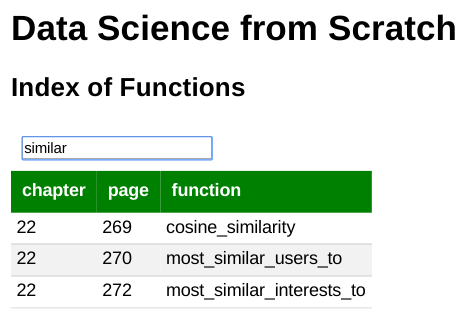The readers of my book have been clamoring for an index of functions,
so that -- for example -- when someone sees me use vector_mean on page 200 they can
easily figure out where to find its definition.
It was easy enough (if tedious) to go through the book and create a spreadsheet, but it also seemed an opportunity to build something in Javascript, which I always unreasonably enjoy.
My idea was pretty simple: a text input that you type in, and a table of
{ function_name, chapter, page } that's filtered (in real-time) by whatever you
type. So if you type "add" you get all the functions that contain "add" somewhere
in their name (e.g. vector_add).

Simple enough, but also a good opportunity to use/learn some newfangled client-side-virtual-dom-javascript-magic framework.
Given my love of all things Purescript, I
built the first version using purescript-halogen.
Unfortunately (or fortunately), I don't understand free monads
well enough to explain it to you. If you understand Purescript (or Haskell) it is
mostly straightforward, save that the halogen library gave me no easy way
(or at least no obvious way) to get at the value of a text input on every
keyup event, which required a lot of ugly hacking around (and made up the bulk
of the time I spent on the project).
Recently I've been poking at cycle.js (whose creator recently wrote an anti-React rant that kind of resonated with me), so I figured I'd try recreating the project using cycle. (It was surprisingly easy and fun, once I got past the self-loathing of using a non-typed language.)
The central idea of cycle is using observables, which are basically lazy streams of values. (If you want types, I believe this is basically the paradigm of Elm, and also there is a purescript-signal library that does this.)
The documentation calls the architecture "Model-View-Intent", but I prefer to think of it as "Intent-Model-View", which is the order in which things happen:
- Intent: given some external source (the DOM, AJAX calls), create a lazy stream of events.
- Model: given a lazy stream of events, turn it into a lazy stream of states.
- View: given a lazy stream of states, turn it into a lazy stream of outputs (in our case, virtual-dom trees)
Each of these can be a pure function (yay!), and the cycle.js machinery hooks these together to create a loop.
In this case, we'll have a text input, and the intent should output its value every time there is a keyup event:
function intent(DOM) {
return DOM.select('input').events('keyup')
.map(ev => ev.target.value)
.startWith('');
}
Hopefully this is pretty straightforward. (The startWith('') just says that our stream should
start with an empty string event before any events happen.)
Now the model needs to use that value (our "query") to produce a state. The state should be whatever data we need to produce the output. Here that will be the query itself, as well as the list of functions that satisfy the query:
function model(value$) {
return value$.map(query => ({
query,
entries : indexEntries.filter(entry => (entry.name.indexOf(query) !== -1))
}));
}
(The $-suffix is a cycle convention (maybe broader) to indicate that a variable
is an observable.) This is again pretty simple: given an element of the value$
stream (which is the value of the text input after a keyup),
output a state consisting of both the query and the index entries that match it.
Finally, we need the view to turn that state into a virtual-dom representation:
function view(state$) {
return state$.map(state =>
div([
input({type: 'text',
autofocus: true,
placeholder: 'Search Query',
value: state.query}),
// v-dom table containing the entries
showEntries(state.entries)
]));
}
Given a state, we need a text input with its value set to state.query,
and a table displaying the entries. (Yes, this is one of those setups where
you use Javascript functions to write HTML, deal with it.)
showEntries is not very interesting, but here it is for completeness:
function showEntries(indexEntries) {
return table([
thead([
tr([th('chapter'), th('page'), th('function') ])
]),
tbody(indexEntries.map(entry =>
tr([td('' + entry.chapter), td('' + entry.page), td(entry.name)])
))
]);
}
(The table header contains headings, the table body contains one row for each
index entry. Apparently td requires a string as its input.)
That's essentially it, all that's left is to hook it all together:
function main({DOM}) {
return {DOM: view(model(intent(DOM)))};
}
Cycle.run(main, {
DOM: makeDOMDriver('#app')
});
Here main just takes the DOM source (which is the output of makeDOMDriver)
and returns the virtual-dom sink that we've defined. (Or possibly I got "source"
and "sink" mixed up here, I don't really understand them.)
Anyway, that's it, that's the whole app (modulo a html file that has an div#app
and some hacky CSS and the file that contains the actual "index entries" data).
Because there's lots of ES2015 voodoo, we need to use browserify with all sorts
of plugins, and the output is a disgustingly large 600KB Javascript file. That's
the price of progress, I guess!